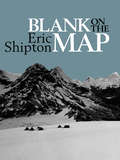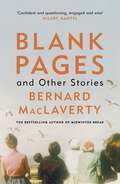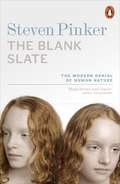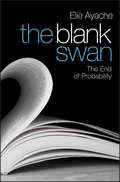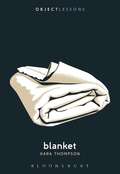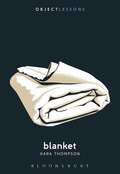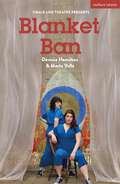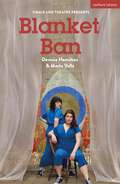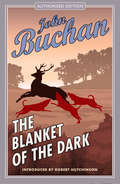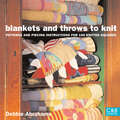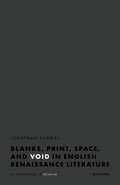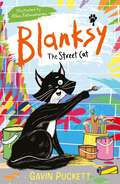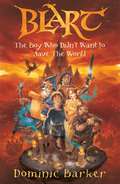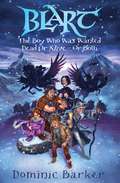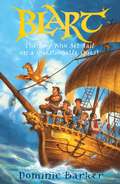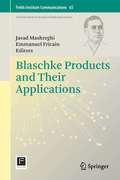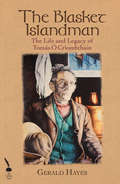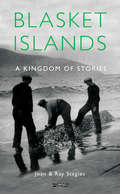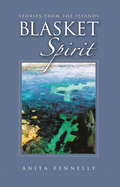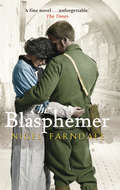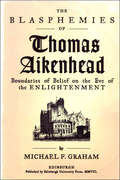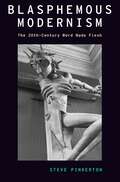- Table View
- List View
Blank on the Map: Pioneering exploration in the Shaksgam valley and Karakoram mountains.
by Eric Shipton'As I studied the maps, one thing about them captured my imagination … Across this blank space was written one challenging word, "Unexplored"' In 1937 two of the twentieth century's greatest explorers set off to explore an unknown area of the Himalaya, the breath-taking Shaksgam mountains. With a team of surveyors and Sherpas, Eric Shipton and H.W. Tilman located and mapped the land around K2, the second-highest mountain in the world. It was their greatest venture, and one that paved the way for all future mountaineering in that area of the Himalaya. For Shipton and Tilman, exploration was everything, with a summit a welcome bonus, and Blank on the Map is the book that best captures their spirit of adventure. With an observant eye and keen sense of humour, Shipton tells how the expedition entered the unknown Shaksgam mountains, crossing impenetrable gorges, huge rivers and endless snow fields. There's a very human element to in Shipton's dealings with his Sherpa friends, and with his Balti porters, some of whom were helpful, while some were less so. The expedition uncovers traces of ancient cultures and visits vibrant modern civilisations living during the last days of the British Empire. Only when all supplies are exhausted, their clothes in tatters and all equipment lost do the men finally return home. A mountain exploration classic.
Blank Pages and Other Stories
by Bernard MacLavertyThe extraordinary new story collection from one of Ireland's greatest writers and bestselling author of Mindwinter Break.Bernard MacLaverty is a consummately gifted short-story writer and novelist whose work - like that of John McGahern, William Trevor, Edna O'Brien or Colm Tóibín - is deceptively simple on the surface, but carries a turbulent undertow. Everywhere, the dark currents of violence, persecution and regret pull at his subject matter: family love, the making of art, Catholicism, the Troubles and, latterly, ageing.Blank Pages is a collection of twelve extraordinary new stories that show the emotional range of a master. 'Blackthorns', for instance, tells of a poor out-of-work Catholic man who falls gravely ill in the sectarian Northern Ireland of 1942 but is brought back from the brink by an unlikely saviour. The most recently written story here is the harrowing but transcendent 'The End of Days', which imagines the last moments in the life of painter Egon Schiele, watching his wife dying of Spanish flu - the world's worst pandemic, until now.Much of what MacLaverty writes is an amalgam of sadness and joy, of circumlocution and directness. He never wastes words but neither does he ever forget to make them sing. Each story he writes creates a universe.
The Blank Slate: The Modern Denial of Human Nature (Penguin Press Science Ser.)
by Steven Pinker"In a work of outstanding clarity and sheer brilliance Steven Pinker banishes forever fears that a biological understanding of human nature threatens humane values" - Helena Cronin, author of THE ANT and THE PEACOCK."A mind blowing, mind openingexposé. Pinker's profoundly positive arguments for the compatibility of biology and humanism are unrivalled for their scope and depth and should be mandatory, if disquieting, reading"Patricia Goldman-Rakic - Past President of the Society for Neuroscience.
The Blank Swan: The End of Probability
by Elie Ayache"Elie Ayache is the only person to present arguments about The Black Swan and rare events that I had not thought about. He does what philosophical inquiry has always done: to go the extra mile and look at the world in a deeply philosophical way." Nassim Nicholas Taleb, PhD, author of The Black Swan, Distinguished Professor, New York University Polytechnic Institute & Principal, Universa Investments. "Elie Ayache has uniquely straddled the down-to-earth world of money and complex financial derivatives and the abstract world of the mind and philosophy. Insightful and insane in equal measures, this book is not an easy read. I wouldn't recommend this for holiday reading on the beach but perhaps for while sitting in front of a log fire with a large Scotch, or probably several.??? Paul Wilmott, author of Frequently Asked Questions in Quantitative Finance October 19th 1987 was a day of huge change for the global finance industry. On this day the stock market crashed, the Nobel Prize winning Black-Scholes formula failed and volatility smiles were born, and on this day Elie Ayache began his career, on the trading floor of the French Futures and Options Exchange. Experts everywhere sought to find a model for this event, and ways to simulate it in order to avoid a recurrence in the future, but the one thing that struck Elie that day was the belief that what actually happened on 19th October 1987 is simply non reproducible outside 19th October 1987 - you cannot reduce it to a chain of causes and effects, or even to a random generator, that can then be reproduced or represented in a theoretical framework. The Blank Swan is Elie's highly original treatise on the financial markets – presenting a totally revolutionary rethinking of derivative pricing and technology. It is not a diatribe against Nassim Taleb's The Black Swan, but criticises the whole background or framework of predictable and unpredictable events – white and black swans alike – , i.e. the very category of prediction. In this revolutionary book, Elie redefines the components of the technology needed to price and trade derivatives. Most importantly, and drawing on a long tradition of philosophy of the event from Henri Bergson to Gilles Deleuze, to Alain Badiou, and on a recent brand of philosophy of contingency, embodied by the speculative materialism of Quentin Meillassoux, Elie redefines the market itself against the common perceptions of orthodox financial theory, general equilibrium theory and the sociology of finance. This book will change the way that we think about derivatives and approach the market. If anything, derivatives should be renamed contingent claims, where contingency is now absolute and no longer derivative, and the market is just its medium. The book also establishes the missing link between quantitative modelling (no longer dependent on probability theory but on a novel brand of mathematics which Elie calls the mathematics of price) and the reality of the market."
The Blank Swan: The End of Probability
by Elie Ayache"Elie Ayache is the only person to present arguments about The Black Swan and rare events that I had not thought about. He does what philosophical inquiry has always done: to go the extra mile and look at the world in a deeply philosophical way." Nassim Nicholas Taleb, PhD, author of The Black Swan, Distinguished Professor, New York University Polytechnic Institute & Principal, Universa Investments. "Elie Ayache has uniquely straddled the down-to-earth world of money and complex financial derivatives and the abstract world of the mind and philosophy. Insightful and insane in equal measures, this book is not an easy read. I wouldn't recommend this for holiday reading on the beach but perhaps for while sitting in front of a log fire with a large Scotch, or probably several.??? Paul Wilmott, author of Frequently Asked Questions in Quantitative Finance October 19th 1987 was a day of huge change for the global finance industry. On this day the stock market crashed, the Nobel Prize winning Black-Scholes formula failed and volatility smiles were born, and on this day Elie Ayache began his career, on the trading floor of the French Futures and Options Exchange. Experts everywhere sought to find a model for this event, and ways to simulate it in order to avoid a recurrence in the future, but the one thing that struck Elie that day was the belief that what actually happened on 19th October 1987 is simply non reproducible outside 19th October 1987 - you cannot reduce it to a chain of causes and effects, or even to a random generator, that can then be reproduced or represented in a theoretical framework. The Blank Swan is Elie's highly original treatise on the financial markets – presenting a totally revolutionary rethinking of derivative pricing and technology. It is not a diatribe against Nassim Taleb's The Black Swan, but criticises the whole background or framework of predictable and unpredictable events – white and black swans alike – , i.e. the very category of prediction. In this revolutionary book, Elie redefines the components of the technology needed to price and trade derivatives. Most importantly, and drawing on a long tradition of philosophy of the event from Henri Bergson to Gilles Deleuze, to Alain Badiou, and on a recent brand of philosophy of contingency, embodied by the speculative materialism of Quentin Meillassoux, Elie redefines the market itself against the common perceptions of orthodox financial theory, general equilibrium theory and the sociology of finance. This book will change the way that we think about derivatives and approach the market. If anything, derivatives should be renamed contingent claims, where contingency is now absolute and no longer derivative, and the market is just its medium. The book also establishes the missing link between quantitative modelling (no longer dependent on probability theory but on a novel brand of mathematics which Elie calls the mathematics of price) and the reality of the market."
Blank Venn (Boolean) diagram (tactile)
by Sheffield Vi ServiceThis is an image of two overlapping ellipses, which can be labelled and used as a Venn or Boolean diagram representing intersecting sets.
Blanket (Object Lessons)
by Kara ThompsonObject Lessons is a series of short, beautifully designed books about the hidden lives of ordinary things. We are born into blankets. They keep us alive and they cover us in death. We pull and tug on blankets to see us through the night or an illness. They shield us in mourning and witness our most intimate pleasures. Curious, fearless, vulnerable, and critical, Blanket interweaves cultural critique with memoir to cast new light on a ubiquitous object. Kara Thompson reveals blankets everywhere--film, art, geology, disasters, battlefields, resistance, home--and transforms an ordinary thing into a vibrant and vital carrier of stories and secrets, an object of inheritance and belonging, a companion to uncover. Object Lessons is published in partnership with an essay series in the The Atlantic.
Blanket (Object Lessons)
by Kara ThompsonObject Lessons is a series of short, beautifully designed books about the hidden lives of ordinary things. We are born into blankets. They keep us alive and they cover us in death. We pull and tug on blankets to see us through the night or an illness. They shield us in mourning and witness our most intimate pleasures. Curious, fearless, vulnerable, and critical, Blanket interweaves cultural critique with memoir to cast new light on a ubiquitous object. Kara Thompson reveals blankets everywhere--film, art, geology, disasters, battlefields, resistance, home--and transforms an ordinary thing into a vibrant and vital carrier of stories and secrets, an object of inheritance and belonging, a companion to uncover. Object Lessons is published in partnership with an essay series in the The Atlantic.
Blanket Ban (Modern Plays)
by Davinia Hamilton Marta VellaWinner of New Diorama, Underbelly and Methuen Drama's Untapped Award 2022Sometimes I'm afraid of this play.Malta: Catholic kitsch, golden sun, deep blue sea, Eurovision - and a blanket ban on abortion.Propelled by three years of interviews with anonymous contributors and their own lived experience, actors and activists Marta and Davinia interrogate Malta's restrictions on the freedom of women.What does it mean for your home to boast the world's most progressive LGBTQIA rights, leading transgender laws – and a population that is almost unanimously anti-choice?Blanket Ban is a rallying cry from award-winning Chalk Line Theatre. This edition was published to coincide with the production at Underbelly Cowgate, Edinburgh, in August 2022.
Blanket Ban (Modern Plays)
by Davinia Hamilton Marta VellaWinner of New Diorama, Underbelly and Methuen Drama's Untapped Award 2022Sometimes I'm afraid of this play.Malta: Catholic kitsch, golden sun, deep blue sea, Eurovision - and a blanket ban on abortion.Propelled by three years of interviews with anonymous contributors and their own lived experience, actors and activists Marta and Davinia interrogate Malta's restrictions on the freedom of women.What does it mean for your home to boast the world's most progressive LGBTQIA rights, leading transgender laws – and a population that is almost unanimously anti-choice?Blanket Ban is a rallying cry from award-winning Chalk Line Theatre. This edition was published to coincide with the production at Underbelly Cowgate, Edinburgh, in August 2022.
The Blanket of the Dark
by John BuchanTells the story of young clerk Peter Pentecost, who has a claim to the throne, and a tale of intrigue against King Henry VIII, where 'under the blanket of the dark all men are alike and all are nameless'.
Blankets and Throws To Knit: Patterns And Piecing Instructions For 100 Knitted Squares
by Debbie AbrahamsOver 100 different blanket squares can be knitted up to create a dozen unique afghans in a variety of styles. Projects range from baby's first comfort blanket in subdued pastels, to brightly coloured motifs embellished with beads and buttons for the spirited teenager.
Blanks, Print, Space, and Void in English Renaissance Literature: An Archaeology of Absence
by Jonathan SawdayBlanks, Print, Space, and Void in English Renaissance Literature is an inquiry into the empty spaces encountered not just on the pages of printed books in c.1500-1700, but in Renaissance culture more generally. The book argues that print culture in the sixteenth and seventeenth centuries helped to foster the modern idea of the 'gap' (where words, texts, images, and ideas are constructed as missing, lost, withheld, fragmented, or perhaps never devised in the first place). It re-imagines how early modern people reacted not just to printed books and documents of many different kinds, but also how the very idea of emptiness or absence began to be fashioned in a way which still surrounds us. Jonathan Sawday leads the reader through the entire landscape of early modern print culture, discussing topics such as: space and silence; the exploration of the vacuum; the ways in which race and racial identity in early modern England were constructed by the language and technology of print; blackness and whiteness, together with lightness, darkness, and sightlessness; cartography and emptiness; the effect of typography on reading practices; the social spaces of the page; gendered surfaces; hierarchies of information; books of memory; pages constructed as waste or vacant; the genesis of blank forms and early modern bureaucracy; the political and devotional spaces of printed books; the impact of censorship; and the problem posed by texts which lack endings or conclusions. The book itself ends by dwelling on blank or empty pages as a sign of human mortality. Sawday pays close attention to the writings of many of the familiar figures in English Renaissance literary culture - Sidney, Shakespeare, Donne, Jonson, and Milton, for example - as well as introducing readers to a host of lesser-known figures. The book also discusses the work of numerous women writers from the period, including Aphra Behn, Ann Bradstreet, Margaret Cavendish, Lady Jane Gray, Lucy Hutchinson, Æmelia Lanyer, Isabella Whitney, and Lady Mary Wroth.
Blanks, Print, Space, and Void in English Renaissance Literature: An Archaeology of Absence
by Jonathan SawdayBlanks, Print, Space, and Void in English Renaissance Literature is an inquiry into the empty spaces encountered not just on the pages of printed books in c.1500-1700, but in Renaissance culture more generally. The book argues that print culture in the sixteenth and seventeenth centuries helped to foster the modern idea of the 'gap' (where words, texts, images, and ideas are constructed as missing, lost, withheld, fragmented, or perhaps never devised in the first place). It re-imagines how early modern people reacted not just to printed books and documents of many different kinds, but also how the very idea of emptiness or absence began to be fashioned in a way which still surrounds us. Jonathan Sawday leads the reader through the entire landscape of early modern print culture, discussing topics such as: space and silence; the exploration of the vacuum; the ways in which race and racial identity in early modern England were constructed by the language and technology of print; blackness and whiteness, together with lightness, darkness, and sightlessness; cartography and emptiness; the effect of typography on reading practices; the social spaces of the page; gendered surfaces; hierarchies of information; books of memory; pages constructed as waste or vacant; the genesis of blank forms and early modern bureaucracy; the political and devotional spaces of printed books; the impact of censorship; and the problem posed by texts which lack endings or conclusions. The book itself ends by dwelling on blank or empty pages as a sign of human mortality. Sawday pays close attention to the writings of many of the familiar figures in English Renaissance literary culture - Sidney, Shakespeare, Donne, Jonson, and Milton, for example - as well as introducing readers to a host of lesser-known figures. The book also discusses the work of numerous women writers from the period, including Aphra Behn, Ann Bradstreet, Margaret Cavendish, Lady Jane Gray, Lucy Hutchinson, Æmelia Lanyer, Isabella Whitney, and Lady Mary Wroth.
Blanksy the Street Cat
by Gavin PuckettHello there, meow, and how do you do?It's a joy to be sharing my story with you.It's all about friendship, fine music and art,And a busker named Pete . . .When Blanksy the cat discovers a talent for painting murals he uses it to draw bigger and bigger crowds to help his friend Pete the busker become rich. But will money really make Pete happy?A hilarious and heart-warming story with fabulous illustrations by award-winning illustrator Allen Fatimaharan.
Blart: The boy who didn't want to save the world
by Dominic BarkerBlart is not an average boy. He lives on a pig farm with his grandfather and doesn't care about being heroic or famous or legendary, but he does know that if you want to catch a pig you have to sneak up behind it and take it by surprise. So when a great wizard visits and explains that humankind depends on Blart joining his quest, Blart says no - until the wizard threatens his pigs. Reluctantly, Blart embarks on a very epic quest stuffed with brilliant characters: a feisty princess who likes dragons, a warrior who's a big softie at heart, a disaffected dwarf, and evil Zorab, trapped in a mountain, waiting for his minions to dig him out...
Blart 2: The Boy Who Was Wanted Dead Or Alive - Or Both
by Dominic Barker'Inventive, charming and very funny' The ObserverJust as Blart is settling down to enjoy his teenage years on a fabulous pig farm with the proceeds from saving the world, Capablanca returns - with bad news. A terrible oversight in his original world-saving research has led to accusations of no less than collusion with evil Zoltab himself. And now he is a wanted man - and so, by assocation, is BlartTo prove their innocence or else be hounded to the four corners of the earth by a bloodthirsty army, they must locate their comrades from the original quest. Together they may stand a chance of proving that Capablanca's was an innocent mistake, by finding the answer to a great mystery - what exactly did they do with Zoltab? And how could they be so careless as to forget...And so begins another hilarious and unforgettable adventure (with pigs) and a brilliant cast of characters including newcomers Uther Slywort the merchant and sociopathic Baron Killbride.
Blart 3: The boy who set sail on a questionable quest
by Dominic BarkerPrincess Lois has been kidnapped by Anatoly the Handsome, who wants to marry her. Cue 'damsel in distress' to be rescued by none other than our own heroic Blart. He sets out on the good ship The Golden Pig with Olaf the innocent - who believes what everyone says all the time - and Kupverstich the Strange - an explorer-come-scientist whose ingenious explanations for the natural world have one thing in common: they're all wrong. They must battle cut-throat pirates, a sixteen-tentacled octopus, escape the suffocating bureaucracy of Triplicat, where they are briefly marooned, not to mention evade the Guild of Assassins, who have a contract to kill Blart, in their selfless (well, almost) bid to rescue poor Lois. But will they make it in time?
Blaschke Products and Their Applications (Fields Institute Communications #65)
by Javad Mashreghi Emmanuel FricainBlaschke Products and Their Applications presents a collection of survey articles that examine Blaschke products and several of its applications to fields such as approximation theory, differential equations, dynamical systems, harmonic analysis, to name a few. Additionally, this volume illustrates the historical roots of Blaschke products and highlights key research on this topic. For nearly a century, Blaschke products have been researched. Their boundary behaviour, the asymptomatic growth of various integral means and their derivatives, their applications within several branches of mathematics, and their membership in different function spaces and their dynamics, are a few examples of where Blaschke products have shown to be important. The contributions written by experts from various fields of mathematical research will engage graduate students and researches alike, bringing the reader to the forefront of research in the topic. The readers will also discover the various open problems, enabling them to better pursue their own research.
The Blasket Islandman: The Life and Legacy of Tomás Ó Criomhthain
by Gerald HayesTomás Ó Criomhthain (1856–1937) is one of the giants of Irish-language literature. His best-known books, Allagar na hInise and An tOileánach, are acknowledged classics. But he was a highly unlikely author. He lived his entire life on the isolated and now-abandoned Great Blasket, in a house he built with his own hands using stones he found on the island. Likewise, he crafted a valuable literary heritage out of island life. With indefatigable persistence, he steadily built on his modest formal education, learning to read and write in Irish during middle age while simultaneously expanding his knowledge of literature and history. Scholarly visitors were impressed with Tomás’s observations of his tiny community. They encouraged him to commit his stories and memories to paper. He wrote three first-person accounts of his experiences, bequeathing to us a captivating saga of a folk culture doomed by difficult circumstances. His works are among the first examples of Ireland’s transition from oral to written folk storytelling. The Blasket Islandman tells, for the first time, the full story of Tomás’s life, with its many triumphs and travails. This absorbing account also describes the forces that influenced his work and details his impressive legacy. Tomás was determined that his community be remembered. In the process, he achieved a level of immortality for himself. More than eighty years after his passing, he remains the famed ‘Blasket Islandman’ and, to paraphrase the man himself, the like of him will never be again.
Blasket Islands: A Kingdom of Stories
by Joan Stagles Ray StaglesThe Blasket Islands are famous for their writers, lore and unique location off the south-west tip of Ireland. This book is perfect for anyone who wants to explore the Great Blasket Island, learn its history and discover what has captivated visitors and residents in this special place. A beautifully illustrated and compelling history of the life, traditions and customs of an isolated community that has now disappeared. The book traces the fate of the Blasket people and the slow erosion of their culture to that sad day in 1952 when the families were evacuated from the Great Blasket Island.
Blasket Spirit: Stories from the Islands
by Anita FennellySeeking solitude after personal crisis, Anita Fennelly spent a summer alone on the Great Blasket Island. This is her story, written by candelight, of personal healing and recovery interwoven with the island stories, its people, places and wildlife. Anita weaves a tapestry of tales: ghost stories told by the fireside, stories of love and betrayal, stories celebrating womanhood. Ultimately, Anita's own story is one of survival and hope. Blasket Spirit reveals a timeless place where the souls of the past and present are inextricably linked with the emotional and physical struggles of island life.
The Blasphemer: A Novel
by Nigel FarndaleHe had always been scared of flying. Now, the fear is real. A plane crash. The water is rising over his mouth. In his nostrils. Lungs. As Daniel gasps, he swallows; and punches at his seat-belt. Nancy, the woman he loves, is trapped in her seat. He clambers over her, pushing her face into the headrest.It is a reflex, visceral action made without rational thought...But Daniel Kennedy did it. And already we have judged him from the comfort of our own lives.Almost a hundred years earlier, Daniel's great-grandfather goes over the top at Passchendaele.A shell explodes, and he wakes up alone and lost in the hell of no-man's-land. Where are the others? Has he been left behind? And if he doesn't find his unit, is he a deserter?Love; cowardice; trust; forgiveness.How will any of us behave when we are pushed to extremes?
The Blasphemies of Thomas Aikenhead: Boundaries of Belief on the Eve of the Enlightenment
by Michael F. GrahamThis is the first modern book-length study of the case of Thomas Aikenhead, the sometime University of Edinburgh student who in 1697 earned the unfortunate distinction of being the last person executed for blasphemy in Britain.
Blasphemous Modernism: The 20th-Century Word Made Flesh (Modernist Literature and Culture)
by Steve PinkertonScholars have long described modernism as "heretical" or "iconoclastic" in its assaults on secular traditions of form, genre, and decorum. Yet critics have paid surprisingly little attention to the related category of blasphemy--the rhetoric of religious offense--and to the specific ways this rhetoric operates in, and as, literary modernism. United by a shared commitment to "the word made flesh," writers such as James Joyce, Mina Loy, Richard Bruce Nugent, and Djuna Barnes made blasphemy a key component of their modernist practice, profaning the very scriptures and sacraments that fueled their art. In doing so they belied T. S. Eliot's verdict that the forces of secularization had rendered blasphemy obsolete in an increasingly godless century ("a world in which blasphemy is impossible"); their poems and fictions reveal how forcefully religion endured as a cultural force after the Death of God. More, their transgressions spotlight a politics of religion that has seldom engaged the attention of modernist studies. Blasphemy respects no division of church and state, and neither do the writers who wield it to profane all manner of coercive dogmas--including ecclesiastical as well as more worldly ideologies of race, class, nation, empire, gender, and sexuality. The late-century example of Salman Rushdie's The Satanic Verses affords, finally, a demonstration of how modernism persists in postwar anglophone literature and of the critical role blasphemy plays in that persistence. Blasphemous Modernism thus resonates with the broader cultural and ideological concerns that in recent years have enriched the scope of modernist scholarship.
